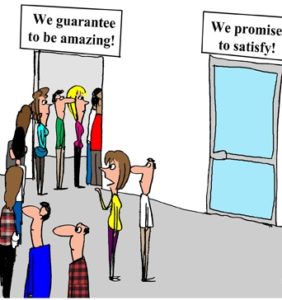
When you provide the right service at the right price, at the right time, and to the agreed-upon specifications, the customer is satisfied. This is the mission of most organizations because they assume that it is sufficient to satisfy customers. But studies conducted on the relationship between customer satisfaction and customer loyalty show that this assumption is deeply flawed.
Xerox, for several years in the past, polled 480,000 customers per year regarding product and service satisfaction using a five-point scale from 1 (lowest) to 5 (highest). Their goal had always been to have 100% of their customers give 4s (satisfied) and 5s (highly satisfied). But in a particular year, the result of the analysis of customers who gave Xerox 4s and 5s showed that the relationships between the scores and actual loyalty differed greatly depending on whether the customers were satisfied or highly satisfied. Customers giving Xerox 5s were six times more likely to repurchase Xerox equipment than those giving 4s.
This has profound implications which are: Satisfied customers are not loyal. Only highly satisfied ones are.
Truth is, however reasonable a customer is, they need to be highly satisfied; if they are not and have a choice, they can be lured away easily. That is why in today’s competitive and rapidly changing market-place, merely satisfying a customer is just not good enough.
Thus, if your organization still aims at making your customers satisfied, then there’s the need to stretch your objective and start aspiring to make them highly satisfied. And making a customer highly satisfied simply requires providing the unexpected or the extra service – the few add-ons that in most cases cost so little.
For example, consider the experience of a customer who wants their car serviced. The customer’s primary goal is to have it serviced properly. The car then goes in for servicing. When the customer is collecting it, everything on the checklist has been carried out correctly. The car is ready on time and the bill is also totally correct. The customer will be satisfied.
Here’s another scenario. When the customer is collecting the car, they find not only that the service has been done properly, bill correct and car ready, but that the car has also been washed, the interior has been vacuumed with a clean white sheet of paper placed in the footwell. And that there is a band of paper around the steering wheel that says, “This car has been serviced by Femi Okafor. If you have any concern, please ask to speak to him.” The customer will be highly satisfied.
In the first scenario of the example, what the auto workshop did was what the customer paid them to do. They carried out their task correctly and made the customer satisfied. This sort of service that makes customers merely satisfied is out of date.
The second scenario of the example shows an outstanding service where the extras made the difference and resulted in the customer being highly satisfied. This is the contemporary customer service model.
The organization that will survive and flourish over the long term is the one that understands how important the level of customer satisfaction is and continually works to do for their customers everything they can do after they have done what they are supposed to do.
So here is an important question to ponder: What are those extra things you can do to give your customer a better experience that will make them highly satisfied?
If you do not find the answers and take action, your competitors will. And when they do, your customers who are merely satisfied will be lured away – making them depart in hard-to-spot dribs.